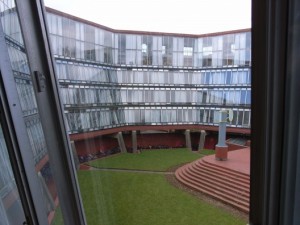In a history of postmodernism (history written on the fly since the book was published in 1984) Heinrich Klotz wrote: “James Stirling has received only one commission in his own country since he made his change to postmodernism, yet what stands in the way of postmodernism in Great Britain is not so much a lack of commissions as a continuing faith in modernism.” As evidence, Klotz cited the successes of Norman Foster, Ove Arup, and Richard Rogers. The persistence of modernism in Britain in the eighties was undoubted, but Stirling’s lack of commissions was due to something else. The trio of red-brick university buildings that launched his career—the University of Leicester Engineering Building, the History Faculty and Library at Cambridge, and the residential Florey Building at Queen’s College, Oxford, were aesthetic successes but rather spectacular technical failures. The glass roofs leaked, both in the engineering building and the library (!), and the heavily glazed spaces were impossibly cold in the winter. In an AD profile of the Florey Building, an ex-resident reminisced about his student days: “The Florey Building was an unmitigated disaster to live in. The arrangement of rooms meant that privacy was only achievable by drawing down blinds, and the aluminum strips connecting windows to walls conducted sound so that one could easily hear conversations in the next room.” Indeed, Florey had so many problems that the university brought a law suit against Stirling’s firm. According to AD, “As a result, Stirling’s office was unable to find work in England for at least a decade after the Florey building, instead finding promise of work in places like Germany, Japan, and the Unites States.”

Florey Building

